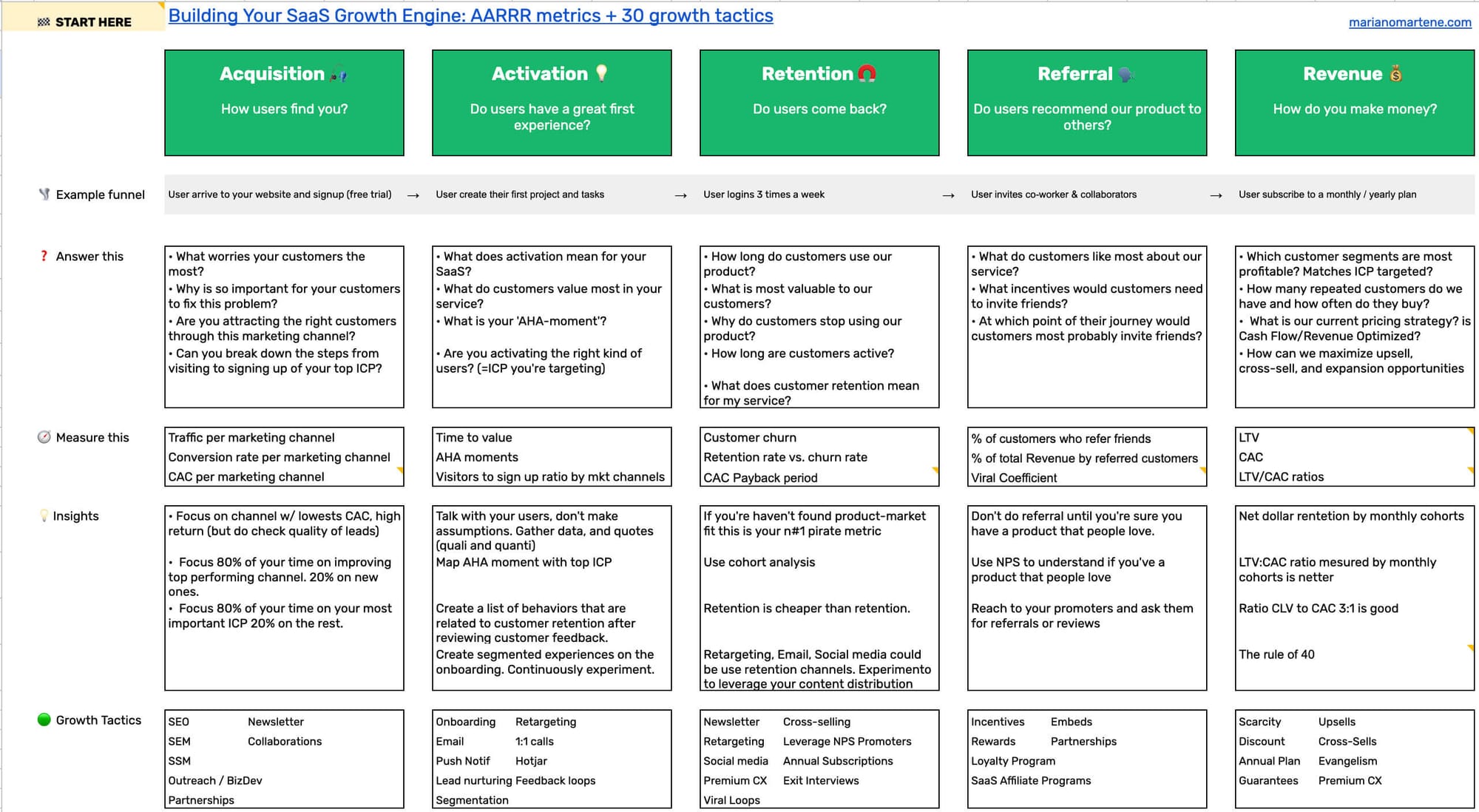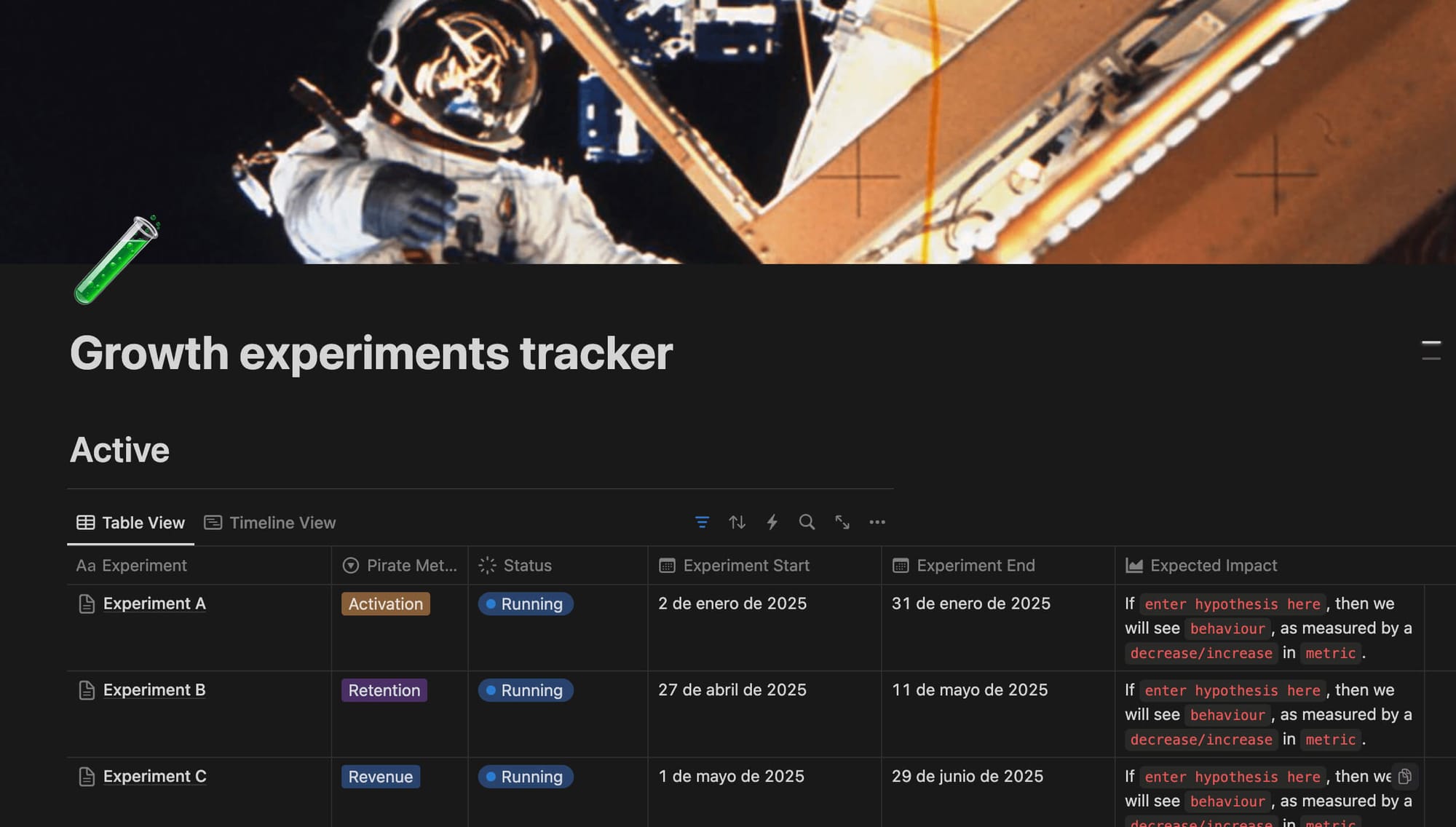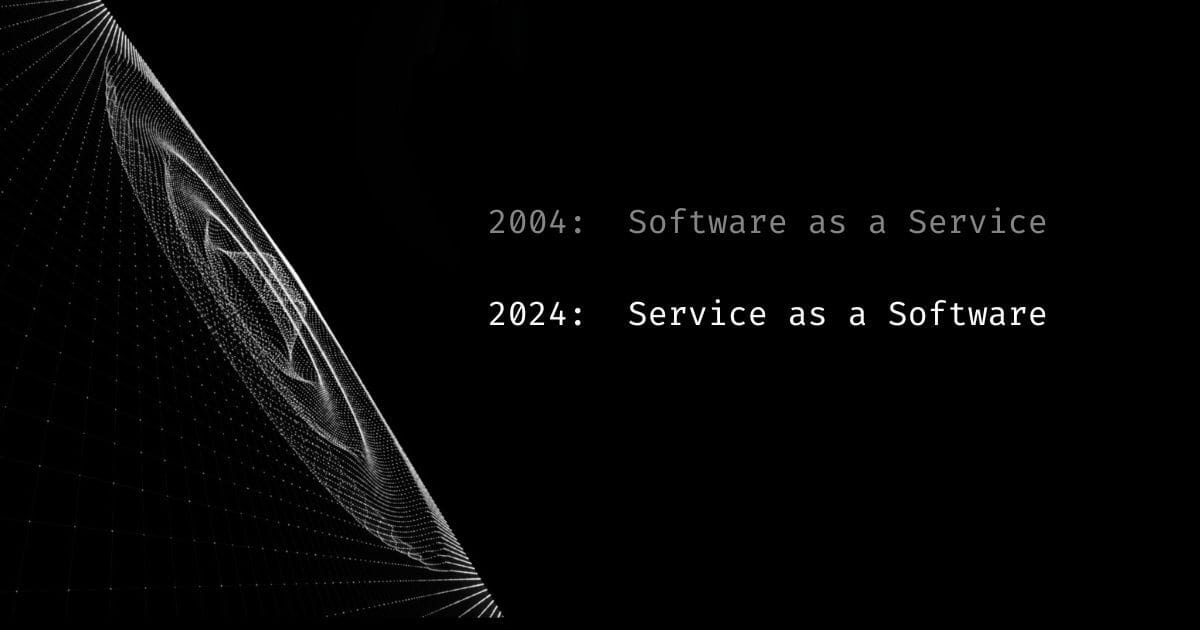This resource pack will help you build your growth foundation. We will explore the AARRR metrics, +30 growth tactics you can use, and how to effectively set up growth experiments to make impactful decisions.
it’s designed to help you figure out what matters, take action, and grow.
let's have a closer look!
Download your files:
What’s inside?
- ▶️ 4' video:
start with the video to see how the AARRR metrics work and how to leverage them for your specific growth stage. - 🏴☠️ AARRR framework spreadsheet:
the AARRR (pirate metrics) framework—Acquisition, Activation, Retention, Revenue, and Referral—is at the heart of this engine. - 🗄️ +30 growth tactics database + experiment tracker
includes +30 actionable tactics to help you experiment and see what works best, along with a dashboard to track your experiments
How to use this resource?
- step 1: determine your stage
Where is your saas right now? are you validating your concept, finding PMF, or scaling up?
↳ tells you what pirate metric you should focus on - step 2: select your pirate metrics
Based on your stage, pick two metrics from the AARRR framework. These metrics will guide what needs to be measured and improved.
↳ tells you what to measure an area of experimentation. - step 3: define tactics and experiment
Use the growth tactics provided to inspire your experiments. The goal is to try, measure, and iterate until you find what works best for you.
↳ determine an experiment that you can execute in 2-weeks or less. - step 4: track and measure in agile sprints
Track all your experiments using the tracker. Work in two-week sprints to test, learn, and act on results
↳ treat your growth team like engineering.
Let's get started
step 1 Every saas is different, and the way you approach growth has to fit where you are:
- Validation: you’re figuring out if the problem you’re solving is real. Your focus here is getting initial traction and feedback.
- Pre-PMF: you’ve got some traction, but now it’s about dialing in on Product-Market Fit. Growth shouldn’t be rushed—experimentation is key.
- Post-PMF: you’ve found PMF. Now, it’s about scaling sustainably, aligning your financial goals, data, and coding efforts to maximize growth.
First you just need people to sign up → then to stick around → then to pay → then to keep paying → then to refer friends
For example, you wouldn’t want to optimize for referrals when you don’t know if anyone even wants your product.
Here is quick rule of thumb for you to follow:
| Growth Stage | Focus Metric (AARRR) | Goal | Example Experiments |
|---|---|---|---|
| Validation | Acquisition & Activation | Validate interest and solve key problems | - feedback loops, outreach |
| - landing page A/B tests | |||
| - CAC and conversion rate analysis | |||
| Pre-Product-Market Fit (Pre-PMF) | Activation & Retention | Confirm Product-Market Fit, engage users | - onboarding improvements (time to value) |
| - retargeting, growth loops | |||
| - cohort analysis for churn reasons | |||
| Post-Product-Market Fit (Post-PMF) | Retention, Referral & Revenue | Scale, reduce churn, optimize revenue | - referral incentives, loyalty programs |
| - up/cross-selling, pricing A/B testing | |||
| - LTV/CAC ratio |
with that in mind, now you can jump to step 2 , and watch the video:
begin here
the AARRR pirate metrics framework is an acronym for a set of five user-behavior metrics that your saas businesses should be tracking:
💡 Activation – Are these people taking the actions we want them to?
🧲 Retention – Are our activated users continuing to engage with the product?
🗣️ Referral – Do users like the product enough to tell others about it?
💰 Revenue – Are our personas willing to pay for this product?
think on your biggest growth problem, and choose two metrics you want to experiment in your saas.

🧪 Setting up growth experiments
now it's time for step 3, define tactics and experiment:
- Define objective → specific, measurable goal (e.g., "increase onboarding rate by 20%"). [activation]
- Generate hypotheses → "we believe [action] will [result] by [percentage]."
- Prioritize with impact/effort → focus on high-impact, low-effort experiments.
extra advice:
- Set up with tracking: Set accurate KPIs for every experiment. Tools like mixpanel or posthog are essential to track user actions effectively (e.g., form completion rates).
- Run growth sprints: Treat growth as engineering—run 1-2 week sprints to plan, execute, and analyze experiments. Review each sprint to iterate effectively.
- Document everything: Keep records of each experiment to build cumulative knowledge.
Don’t underestimate the value of failed experiments—they often provide the most actionable insights.
To setup the experiment you can access my database to get some inspiration.

that said....
you must think by your own!
you're the only one who knows your product and what's going on.
I've also included a simple growth experiments tracker on notion. You should review it every two weeks with your growth team.

Conclusions
Running effective growth experiments isn’t just about coming up with ideas—it's about treating growth with the same discipline as engineering. Set up growth sprints, document results, and constantly iterate based on what you learn.
Sustainable growth is built experiment by experiment, sprint by sprint.
Download your files:
If you're an outsider, subscribe to my newsletter to get my latests resources.

saas-HQ
Resources and bite-sized case studies to grow your SaaS. bi-weekly.





